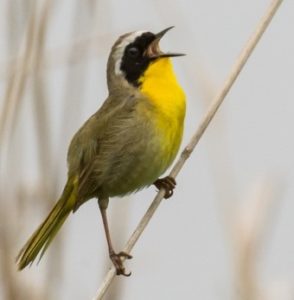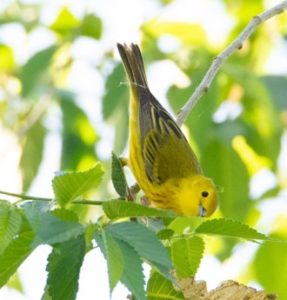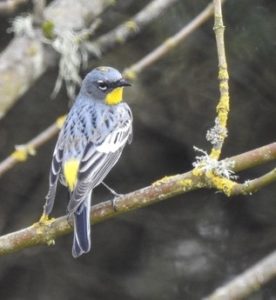Text and photos by Louisa Evers
Please see Part 1 and Part 2 for introductory information and lots of song birds. Bird safely. Contribute to citizen science.
Finches
Finches are small to medium-sized birds with conical bill, sparrow-like bills, and usually short, notched tails. They constantly give distinctive calls in undulating flight and often perch in treetops. Males often have bright red or yellow colors while females are plainer. In flight, finches form loose flocks, with alternating flapping and gliding that resembles bounding or bouncing through the air. Three species of finches have been documented in the park thus far.
Evening Grosbeak – Evening grosbeaks are usually seen flying overhead, perched in treetops, or at bird feeders. They do not mix with other species in winter. They are large and short-tailed with massive heads and beaks. Males have bright yellow over their eyes, back, and bellies and white secondary flight feathers. Females are more olive gray in color. Look for them around the Russian olives in the park. Evening grosbeaks do not breed in this area, but they can winter here.
House Finch – House finches are another common backyard bird that comes to feeders with black oil sunflower seeds and safflower seeds. They often nest on or near buildings. Overall these are brown birds with streaked underparts but males have red foreheads and breasts. Occasionally a male will be orange or yellow instead. House finches can be found in the trees throughout the part, but most commonly in the denser patches of trees.
American Goldfinch – American goldfinches are usually seen in trees feeding on buds or seeds and in grassy areas feeding on seeds so may be spotted most anywhere in the park. In the non-breeding season, these birds are brownish or grayish with two white wing bars in black wings, and a pinkish bill. Males have brighter yellow patches. During breeding, males are bright yellow with a black forehead, wings and tail. Females become a little more yellowish during breeding but generally remain drab when compared to the males. Their flight call is distinctive, often rendered as po-tat-o chip.
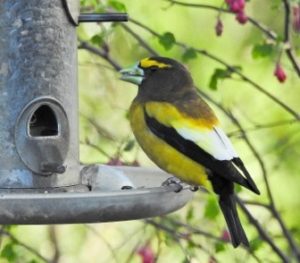
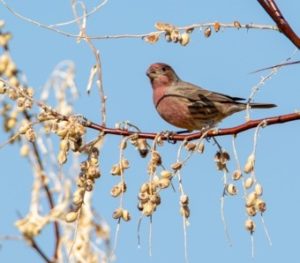
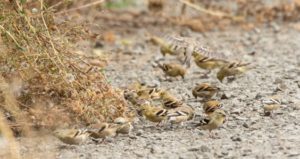
Sparrows
Sparrows are the stereotypical “little brown bird.” Many sparrows are streaky with short, conical bills. Most are found in grassy and brushy areas. Sparrows mostly feed on the ground using a double-scratch method of kicking both feet back simultaneously. Some species form large pure or mixed flocks in winter while others have very specific habitat requirements and do not flock. Birders have spotted five species of sparrows so far.
Dark-eyed Junco – this is another common backyard bird in winter coming to white millet and sunflower seeds. While there are several variants of juncos, the most common is the Oregon race. These birds have dark heads and necks, pink bills, brown backs and flanks, and white outer tail feathers usually seen in flight. Juncos winter in the Treasure Valley and in the park are seen in and near denser brush and feeding in the open grassy areas near two-tracks and trail edges.
White-crowned Sparrow – this is another winter visitor that heads north and into the mountains in the spring. You can find them in dense brush in the park, although they may also be seen foraging in the grassy areas near brush. White crowned sparrows have black and white stripes on their heads in a pattern reminiscent of a bicycle helmet, an orange-pink bill, unstreaked gray breasts, and brown patterned backs.
Song Sparrow – song sparrows are present year-round and are most common in the park in dense brush near water. They also use the cattails in the marshy area. These are brown sparrows with coarse streaks on their breasts and flanks and usually with a central dark spot on their breast.
Lincoln’s Sparrow – at first glance, you can easily mistake a Lincoln’s sparrow for a song sparrow as they are quite similar in appearance. However, Lincoln’s sparrows have much finer streaks in their breasts and flanks along with a buffy breast and flanks. These birds are usually seen singly in or near dense brush in the park. Lincoln’s sparrows pass through the area during migration but do not winter or breed here.
Spotted Towhee – spotted towhees are year-round residents of the area, rarely venturing far from dense brush. They forage on the ground, scratching vigorously for seeds and insects. Males have black heads, breasts, backs and tails, white spots in the wings, orange flanks, and white bellies. Females are brown instead of black. During the breeding season, towhees are more visible as they sing from the tops of shrubs and small trees.
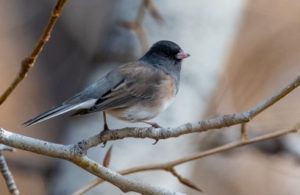
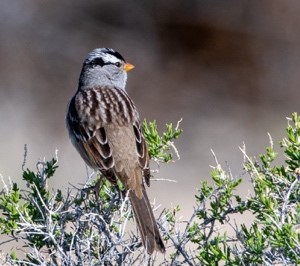
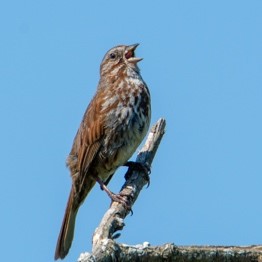
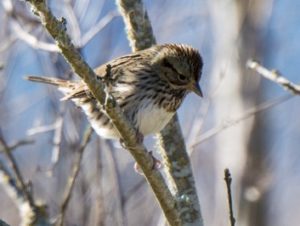
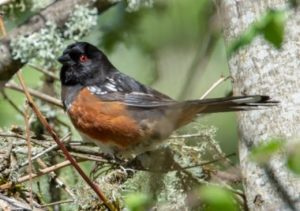
Blackbirds
Blackbirds are medium to large birds and most have long, heavy, pointed bills and long tails. Some blackbirds are not black, but quite colorful. Three blackbirds have been documented and evidence for a fourth species is common.
Western Meadowlark – many are surprised that this colorful singer is a member of the blackbird family. Western meadowlarks are common in grasslands, agricultural fields, and shrub-steppe. Meadowlarks are year-round residents in southwest Idaho, but more common in sagebrush-steppe than near towns, so the birds seen in the park may or may not stick around. Adults have brown mottled backs and tails with white outer tail feathers. During breeding, adults have bright yellow throats and bellies with a black V on the breast, and whitish flanks with black spots arranged in rows.
Red-winged Blackbird – the males are black birds with pointed bills, a yellow stripe in the wings, and a bright red patch, known as an epaulet. When not displaying, the red patch is hidden and the yellow stripe may be less conspicuous. Females can be mistaken for sparrows as they are dark brown, streaky birds. However, their bills are pointed instead of conical. Red-winged blackbirds are found in the cattail marshy area and occasionally in shrubs along the Boise River.
Brewer’s Blackbird – Brewer’s blackbirds are common in openings, yards, agricultural fields, and parking lots. Males are a glossy black with purple and green highlights in the right light and a light colored eye. Females are drab gray-brown with a dark eye. Look for Brewer’s blackbirds feeding in the adjacent fields and the open areas of the park.
Bullock’s Oriole – this migrant has not shown up yet but should soon. The gray pouches hanging in trees scattered through the Park are oriole nests, so we can expect them to be present. Look for them in the cottonwood trees in the park. Males are bright orange with black crowns, backs, and tails, a small black bib, a black line through the eye, and a large white patch in the wings. Females are duller, gray instead of black and orangey-yellow instead of bright orange. They also lack the large white patch in the wings.
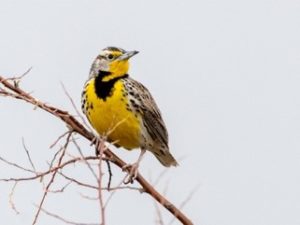
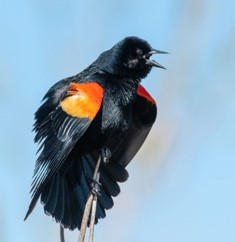
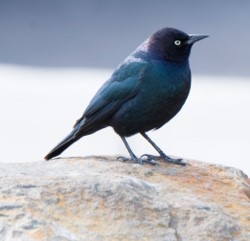
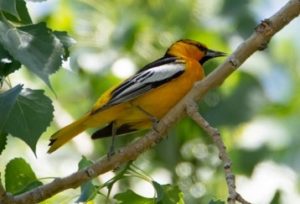
Wood-Warblers
Warblers are small, active birds with short, pointed bills. Many species are brightly colored in yellow, blue, and green, and often have bold, contrasting patterns. Warblers are mostly solitary and migratory and feed on small insects gleaned from leaves and twigs. If you can learn the songs, these are very useful in identifying these often secretive birds. Thus far, only one warbler has been seen, but there is potential for at least two other species.
Yellow-rumped Warbler – yellow-rumped warblers mostly winter in this area and have been seen in the cottonwoods of the park. They form loose flocks in winter so several may be seen at once. They glean insects from branches and buds and sally out to catch flying insects in mid-air. Both males and females have yellow patch on the rump, so many birders call them butter-butts. The Audubon’s race is the most common variant in Idaho. Males have a yellow patch on the crown, a bright yellow throat and yellow flanks, black breast, and white patches above and below the eye. Females lack the yellow patch on the crown and their throats are usually only pale yellow.
Yellow Warbler – males are bright yellow to yellow-green with a dark eye and red streaks on their undersides. Females are more yellow-green. Both sexes have bright yellow under the tail. The first yellow warbler was spotted in the east end of the proposed park in dense understory along the Boise River on April 25.
Common Yellowthroat – this species may show up in the shrubs along the Boise River, in the marshy area, or both later this spring. Their song is a distinctive wi-che-ty wi-che-ty wi-che-ty, although some birds drop a syllable. Males have brown backs, tails, and crowns, and white stripe over a black mask, and bright yellow throat and yellow under the tail. Females lack the black mask and bright yellow but have yellow under the tail and pale yellow throats.
